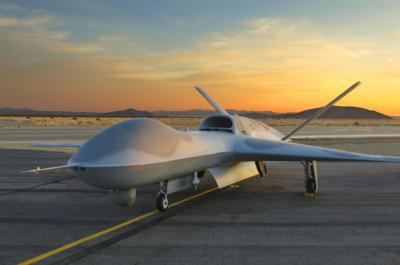Wed, Jan 18, 2023
New Learning Algos Allow Autonomous Thread Avoidance, Environmental Survey
General Atomics (GA-ASI) has continued its work integrating AI 'pilots' on the Open Mission System (OMS) software stack, announcing headway on flight-ready autonomous aircraft in multi-objective testing.

The company advanced its Collaborative Combat Aircraft (CCA) ecosystem with a battery of test missions with artificially intelligent (AI) pilots, evaluating their ability to undergo collaborative combat missions. The flights took place at General Atomics' Desert Horizons flight operations facility in El Mirage, California. In it, a company-owned Avenger UAV was paired with “digital twin” aircraft to autonomously conduct Live, Virtual, and Constructive (LVC) multi-objective collaborative combat missions, putting the digital wingmen through their paces as hands-off combat assets. Throughout the flights, General Atomics sought to enhance the capabilities of its AI systems to "make decisions under dynamic and uncertain
real-world conditions".
As is always the case in software, however, it's much easier said than done. The company's novel Reinforcement Learning (RL) architecture leans heavily on the software industry's ever-present "agile methodology" and a suite of industry tools like Docker and Kubernetes to develop an operationally relevant learning algorithm. So far, their Reinforcement Learning software has demonstrated a few promising behaviors, being able to fly both a live and virtual Avenger simultaneously.

While doing so, a single RL agent was able to chase a target while avoiding threats. A hierarchical RL agent was able to collate sensor data and select appropriate courses of action while in flight, demonstrating the "AI pilot"'s ability to act on real-time information without human input. While performance has largely been suitable to basic threat avoidance and route mapping, General Atomics expects to see compounding benefits as additional AI pilot data is fed into their 'rapid retaining process' for analysis and reuse.
“The concepts demonstrated by these flights set the standard for operationally relevant mission systems capabilities on CCA platforms,” said GA-ASI Senior Director of Advanced Programs Michael Atwood. “The combination of airborne high-performance computing, sensor fusion, human-machine teaming, and AI pilots making decisions at the speed of relevance shows how quickly GA-ASI’s capabilities are maturing as we move to operationalize autonomy for CCAs.”
More News
“Honored to accept this mission. Time to take over space. Let’s launch.” Source: SecTrans Sean Duffy commenting after President Donald Trump appointed U.S. Secret>[...]
Permanent Echo Radar signals reflected from fixed objects on the earth's surface; e.g., buildings, towers, terrain. Permanent echoes are distinguished from “ground clutter&rd>[...]
Aero Linx: European Hang Gliding and Paragliding Union (EHPU) The general aim of the EHPU is to promote and protect hang gliding and paragliding in Europe. In order to achieve this>[...]
Glider Encountered A Loss Of Lift And There Was Not Sufficient Altitude To Reach The Airport Analysis: The flight instructor reported that while turning final, the glider encounter>[...]
Airplane Climbed To 100 Ft Above Ground Level, At Which Time The Airplane Experienced A Total Loss Of Engine Power On May 24, 2025, at 1300 eastern daylight time, an Aeronca 7AC, N>[...]
 Aero-News: Quote of the Day (07.11.25)
Aero-News: Quote of the Day (07.11.25) ANN's Daily Aero-Term (07.11.25): Permanent Echo
ANN's Daily Aero-Term (07.11.25): Permanent Echo ANN's Daily Aero-Linx (07.11.25)
ANN's Daily Aero-Linx (07.11.25) NTSB Final Report: Schweizer SGS 2-33A
NTSB Final Report: Schweizer SGS 2-33A NTSB Prelim: Aeronca 7AC
NTSB Prelim: Aeronca 7AC




